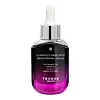What's inside
What's inside
 Key Ingredients
Key Ingredients

 Benefits
Benefits

 Concerns
Concerns

 Ingredients Side-by-side
Ingredients Side-by-side

Water
Skin ConditioningCocamidopropyl Betaine
CleansingPolysorbate 20
EmulsifyingSodium Cocoamphoacetate
CleansingPEG-120 Methyl Glucose Dioleate
EmulsifyingNiacinamide
SmoothingArtemisia Capillaris Extract
Centella Asiatica Extract
CleansingChamomilla Recutita Extract
Skin ConditioningGlucosyl Ceramide
Skin ConditioningFomes Officinalis Extract
Skin ProtectingSaccharomyces Ferment Filtrate
HumectantRosmarinus Officinalis Leaf Water
MaskingScutellaria Baicalensis Root Powder
AbrasiveCamellia Sinensis Leaf Extract
AntimicrobialPolygonum Cuspidatum Root Extract
AntioxidantSalicylic Acid
MaskingSodium Lactate
BufferingHexamidine Diisethionate
EmollientDisodium Cocoyl Glutamate
CleansingWater, Cocamidopropyl Betaine, Polysorbate 20, Sodium Cocoamphoacetate, PEG-120 Methyl Glucose Dioleate, Niacinamide, Artemisia Capillaris Extract, Centella Asiatica Extract, Chamomilla Recutita Extract, Glucosyl Ceramide, Fomes Officinalis Extract, Saccharomyces Ferment Filtrate, Rosmarinus Officinalis Leaf Water, Scutellaria Baicalensis Root Powder, Camellia Sinensis Leaf Extract, Polygonum Cuspidatum Root Extract, Salicylic Acid, Sodium Lactate, Hexamidine Diisethionate, Disodium Cocoyl Glutamate
Water
Skin ConditioningNiacinamide
SmoothingCyclopentasiloxane
Emollient1,2-Hexanediol
Skin ConditioningMethylpropanediol
SolventAluminum Starch Octenylsuccinate
AbsorbentGlucosyl Ceramide
Skin ConditioningCeramide EOP
Skin ConditioningCeramide Ns
Skin ConditioningCeramide NP
Skin ConditioningCeramide As
Skin ConditioningCeramide AP
Skin ConditioningSodium Lactate
BufferingGlycine
BufferingFructose
HumectantInositol
HumectantLactic Acid
BufferingUrea
BufferingSodium PCA
HumectantSodium Benzoate
MaskingHyaluronic Acid
HumectantHydrolyzed Hyaluronic Acid
HumectantSodium Hyaluronate Crosspolymer
HumectantSodium Hyaluronate
HumectantSodium Carboxymethyl Hyaluronate
HumectantSodium Acetylated Hyaluronate
HumectantPotassium Hyaluronate
Skin ConditioningHydroxypropyltrimonium Hyaluronate
Hydrolyzed Sodium Hyaluronate
Skin ConditioningDimethylsilanol Hyaluronate
HumectantSoluble Collagen
HumectantPortulaca Oleracea Extract
Skin ConditioningTrimethylpentanediol/Adipic Acid Copolymer
Skin ConditioningDipotassium Glycyrrhizate
HumectantGlycerin
HumectantPhenoxyethanol
PreservativeSodium Polyacrylate
AbsorbentDicaprylyl Carbonate
EmollientPolyglyceryl-3 Caprate
EmulsifyingAllantoin
Skin ConditioningPolysorbate 20
EmulsifyingPhytosphingosine
Skin ConditioningCholesterol
EmollientSodium Lauroyl Lactylate
EmulsifyingCarbomer
Emulsion StabilisingXanthan Gum
EmulsifyingPentylene Glycol
Skin ConditioningParfum
MaskingWater, Niacinamide, Cyclopentasiloxane, 1,2-Hexanediol, Methylpropanediol, Aluminum Starch Octenylsuccinate, Glucosyl Ceramide, Ceramide EOP, Ceramide Ns, Ceramide NP, Ceramide As, Ceramide AP, Sodium Lactate, Glycine, Fructose, Inositol, Lactic Acid, Urea, Sodium PCA, Sodium Benzoate, Hyaluronic Acid, Hydrolyzed Hyaluronic Acid, Sodium Hyaluronate Crosspolymer, Sodium Hyaluronate, Sodium Carboxymethyl Hyaluronate, Sodium Acetylated Hyaluronate, Potassium Hyaluronate, Hydroxypropyltrimonium Hyaluronate, Hydrolyzed Sodium Hyaluronate, Dimethylsilanol Hyaluronate, Soluble Collagen, Portulaca Oleracea Extract, Trimethylpentanediol/Adipic Acid Copolymer, Dipotassium Glycyrrhizate, Glycerin, Phenoxyethanol, Sodium Polyacrylate, Dicaprylyl Carbonate, Polyglyceryl-3 Caprate, Allantoin, Polysorbate 20, Phytosphingosine, Cholesterol, Sodium Lauroyl Lactylate, Carbomer, Xanthan Gum, Pentylene Glycol, Parfum
Ingredients Explained
These ingredients are found in both products.
Ingredients higher up in an ingredient list are typically present in a larger amount.
Glucosyl Ceramide is made from glucose and a ceramide. It has skin hydrating and barrier repair properties.
This ingredient is naturally found in the epidermis, or upper layers of skin, as the main glycosphingolipid. Glycosphingolipids play a role in maintaining a strong and hydrated skin barrier.
Fun fact: Consuming glucosyl ceramide has been shown to provide skin benefits. You can get your intake by eating wheat, corn, soybeans, and shiitake mushrooms.
Learn more about Glucosyl CeramideNiacinamide is a multitasking form of vitamin B3 that strengthens the skin barrier, reduces pores and dark spots, regulates oil, and improves signs of aging.
And the best part? It's gentle and well-tolerated by most skin types, including sensitive and reactive skin.
You might have heard of "niacin flush", or the reddening of skin that causes itchiness. Niacinamide has not been found to cause this.
In very rare cases, some individuals may not be able to tolerate niacinamide at all or experience an allergic reaction to it.
If you are experiencing flaking, irritation, and dryness with this ingredient, be sure to double check all your products as this ingredient can be found in all categories of skincare.
When incorporating niacinamide into your routine, look out for concentration amounts. Typically, 5% niacinamide provides benefits such as fading dark spots. However, if you have sensitive skin, it is better to begin with a smaller concentration.
When you apply niacinamide to your skin, your body converts it into nicotinamide adenine dinucleotide (NAD). NAD is an essential coenzyme that is already found in your cells as "fuel" and powers countless biological processes.
In your skin, NAD helps repair cell damage, produce new healthy cells, support collagen production, strengthen the skin barrier, and fight environmental stressors (like UV and pollution).
Our natural NAD levels start to decline with age, leading to slower skin repair, visible aging, and a weaker skin barrier. By providing your skin niacinamide, you're recharging your skin's NAD levels. This leads to stronger, healthier, and younger looking skin.
Another name for vitamin B3 is nicotinamide. This vitamin is water-soluble and our bodies don't store it. We obtain Vitamin B3 from either food or skincare. Meat, fish, wheat, yeast, and leafy greens contain vitamin B3.
The type of niacinamide used in skincare is synthetically created.
Learn more about NiacinamidePolysorbate 20 is made by combining ethoxylation of sorbitan, ethylene oxide, and lauric acid. It is a mild cleansing agent, surfactant, and emulsifier.
As a surfactant, it helps collect dirt and oils for washing. Emulsifiers prevent oils and water from separating.
Polysorbate 20 also adds scent to a product. Since it is made using sorbitol, it has a sweet scent. Sorbitol can also be found in fruits such as apples and peaches.
The lauric acid used to create Polysorbate 20 is often derived from coconuts.
Polysorbate 20 may not be fungal acne safe.
Learn more about Polysorbate 20Sodium Lactate is the sodium salt of lactic acid, an AHA. It is a humectant and sometimes used to adjust the pH of a product.
This ingredient is part of our skin's NMF, or natural moisturizing factor. Our NMF is essential for the hydration of our top skin layers and plasticity of skin. NMF also influences our skin's natural acid mantle and pH, which protects our skin from harmful bacteria.
High percentages of Sodium Lactate can have an exfoliating effect.
Fun fact: Sodium Lactate is produced from fermented sugar.
Learn more about Sodium LactateWater. It's the most common cosmetic ingredient of all. You'll usually see it at the top of ingredient lists, meaning that it makes up the largest part of the product.
So why is it so popular? Water most often acts as a solvent - this means that it helps dissolve other ingredients into the formulation.
You'll also recognize water as that liquid we all need to stay alive. If you see this, drink a glass of water. Stay hydrated!
Learn more about Water